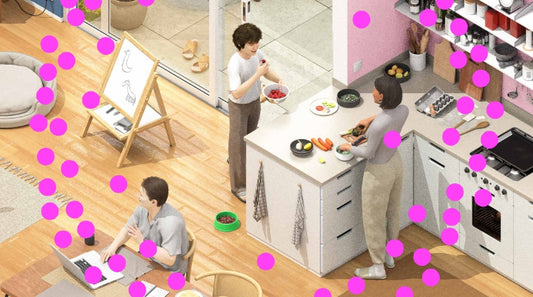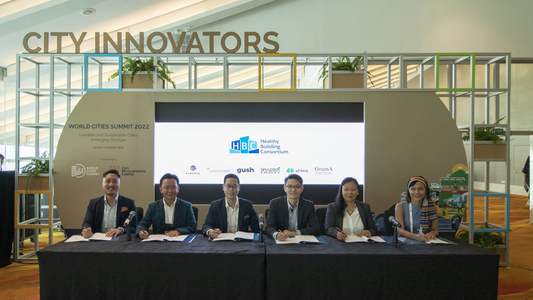Sustainability
How Gush contributes to the greening of built environments

Introduction
Green buildings are beautiful. Beyond looking absolutely stunning in design, they come chock-full-of sustainability awards and accolades, and best of all: they feel good to live and work in. That’s because they represent something bigger — care for humanity and the environment. It’s also quite a feat considering the building sector is responsible for significant emissions into the environment, second to industrial production, and far behind transportation. That’s pretty alarming. How do we push forward for the greening of built environments, and how does Gush fit in the picture? Let’s dive straight into it.
 DBS Newton Green, a net zero building.
DBS Newton Green, a net zero building.
The bigger picture
The Singapore Green Plan 2030 has many concrete goals. But with regards to the building sector, there are 3 main goals outlined:
- Green 80% of Singapore’s buildings (by Gross Floor Area) by 2030
- 80% of new buildings (by Gross Floor Area) to be Super Low Energy buildings from 2030
- Best-in-class green buildings to see an 80% improvement in energy efficiency (over 2005 levels) by 2030
To achieve these goals, the Building Construction Authority (BCA) has initiated a S$63 million Green Mark Incentive Scheme for Existing Buildings. This scheme provides the much-needed funds for building owners to retrofit their buildings for increased energy efficiency.

The significance of greening
The way we see it, the benefits of greening come in 3 main categories that overlap with one another.
For the planet
Global warming and climate change are very much real and we need effective measures to counter them. Generally, we’re looking at reducing carbon footprint in buildings and shifting away from energy-intensive reliance on air conditioning — a major contributor to environmental strain and the Urban Heat Island (UHI) effect. We need to be be kinder to the environment.

For occupants’ health and comfort
Greening efforts also have profound effects for occupants. We all know this for a fact — cooler spaces makes for better productivity, while intense heat does not. In fact, the World Health Organisation (WHO) recommends indoor temperatures of 32°C during the day and 24°C at night as optimum. Unfortunately, reliance on air-conditioning contributes to a hotter environment, as these units release hot air into the outdoors — creating a heat envelope in cities.
Besides that, sustainable practices on a corporate and building level resonates deeply with a younger workforce. A recent survey conducted indicated that more than half of respondents believe that sustainability is a key factor when deciding on an employer.

Cost efficiency
There is a perception that going green is costly. However, the return on investment is well worth it, materialising easily within 4 - 5 years. To ease this transition, government schemes and subsidies exist to help building owners and corporations.
News broke that there will be a 4.1% increase in electricity tariffs between January - March 2024. Costs will always be rising, and we need to find ways to keep up with it in a cost-effective and sustainable manner with long term in mind. That might mean investing in more upfront, then enjoying the benefits as the years go by.

How can buildings go green?
Generally, it involves the use of low carbon materials, facilitating natural ventilation, utilising efficient lighting and appliances and minimising heat absorption. A combination of these strategies are the recipe for a successful greening.
How does Gush play a role?
Based on the realities of the Urban Heat Island (UHI) effect, we know for a fact that building materials contribute to the intense heat we feel. Buildings are made of concrete walls and glass windows — known for absorbing and transmitting heat to the indoors. With that in mind, we created solutions for both these problems — solar reflective exterior paint, and solar window films to aid in the minimisation of heat absorption. In term, this reduces cooling-related energy consumption (i.e., air-conditioning usage), which in turn reduces costs, reduces carbon footprint, and contributes to the greening of a building.

Gush Cool X (X for exterior paints) is a solar reflective exterior paint that reflects heat and light, contributing to a proven 11.6% reduction of cooling energy consumption. Our formulation contains nano hollow glass microspheres that act as air pockets — creating an insulated layer that effectively block the transfer of heat, reducing the amount of thermal energy entering the building from exterior walls. These microspheres also reflect sunlight, lowering the surface temperature of the surface. All in all, this keeps buildings cooler.

Gush ClearCool on the other hand, forms a range of solar window films with a variety of tints. Our flagship window film, Gush ClearCool 76 is the most transparent, while still being able to block up a huge deal of heat carrying Ultra-Violet (UV) and Infra-red (IR) spectrums, this means that the beautiful views intended with the windows are not compromised, at all. Depending on a building’s needs for privacy, we have since also developed an entire range from allowing between 6.8 - 76% of visible light in. Beyond light, it also rejects up to 99.7% of UV rays — responsible for the degradation of furniture, skin issues and also aging — and 97% of IR — responsible for the heat we feel. To learn more about Gush ClearCool’s efficiency, read more about the tests we conducted.
Using both these products in a building works against heat, and keeps spaces cooler. The end goal is simple: to keep spaces as naturally cool as possible, reducing the need to reach for the air-conditioning remote and reducing household and commercial energy costs.
Case study - Gush Cool X at BCA Skylab
In a study conducted at BCA Academy’s Skylab, adjoining rooms were painted with Gush Cool X and a conventional paint respectively, while the interior of the rooms were kept at consistent test conditions.

The results on normal days showed a reduction of 11.7% in heat transferred that translates to that equivalent of cooling energy savings.

Case study - Gush ClearCool at NTU
High heat translated to lower sales at some NTU cafés. The walkway was fashioned in all glass — notorious for absorbing and trapping heat within enclosed spaces. This made the walk from one end of the campus to the other almost unbearable, with high heat discomfort along the walkway.

After applying Gush ClearCool, the results show a significant dip in solar energy transmittance and lux level. Lux level refers to the unit of measurement that measures the amount of solar energy on a surface.

Case study — Gush ClearCool at BCA Skylab
To obtain real numbers that prove the efficacy of Gush ClearCool, we conducted a test at BCA Academy. 2 adjourning rooms were temperature controlled and kept to the same conditions. One room was coated with Gush ClearCool and the other was left as-is.

Left: windows as-is. Right: windows coated with Gush ClearCool

The results show an average of 9.86% of cooling energy savings. However, the test was done with a fixed fan coil speed — not representative of a typical building. When we redid the test with a variable fan coil speed that’s more indicative of typical buildings, the cooling energy consumption savings increased to 14.45% as compared to the room without our window films. When tested on untreated glass, the recorded temperature was at 42°C; while on treated glass, the temperature showed 33.8°C — a differential of -8.2°C.
Gush's commitment
Gush, alongside five other sustainable companies, had signed a Memorandum of Understanding (MoU) emphasising cooperation in creating environments that prioritise the health and wellbeing of building occupants. Here’s what our founder and CEO had to say about it:
“It’s heartening to see infrastructure getting sustainable as buildings constitute a large percentage of aggregate energy requirements, yet it’s important to note that buildings were fundamentally constructed for their occupants. We’re excited to be able to champion the additional paradigm of health for the occupants, on top of sustainability, within the built environment.”
While we’re committed to the greening of buildings by improving energy efficiency and reducing energy costs, we also believe in creating cooler and healthier environments for occupants who inhabit these buildings.

Seal of approval
Gush’s commitment to sustainability is substantiated by certifications such as SGBC 4 ticks, GreenLabel, and HK CIC for Gush Cool X.

Final words
Achieving greener built environments is not only a possibility but a necessity. Here at Gush, this aligns perfectly with why we exist at all. We remain to be an advanced materials company, dedicated to innovating and developing products that improve living spaces and environments. With the new initiatives in place, we hope to be a big part of the greening of buildings in Singapore.






